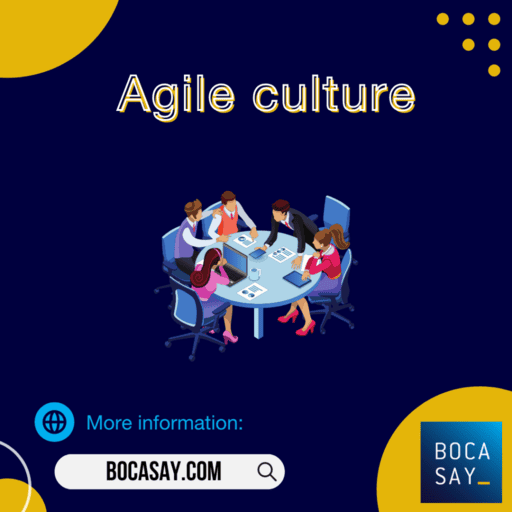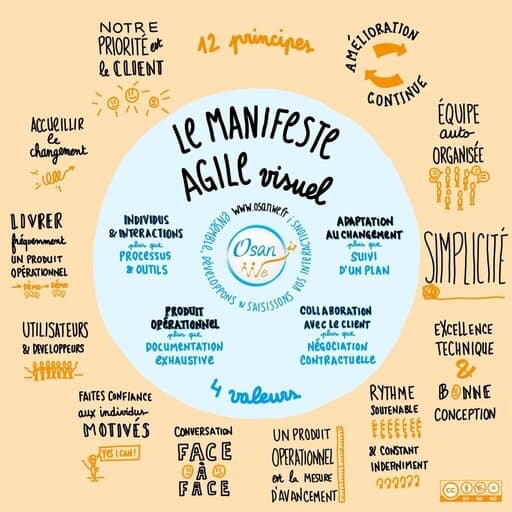What is an agile culture within a company?
Agile is an approach to project management and software development that helps teams deliver value to their customers faster and more efficiently. Requirements and results are continuously assessed, so teams have a natural mechanism to react quickly to change.
What is the agile method?
Method is the ability to create and respond to change. It is a way of dealing with an uncertain and turbulent environment, while keeping the end goal in sight.
It’s really about thinking about how to understand what’s going on in the environment you’re in today, and to identify the uncertainty you’re facing and adapt accordingly.
It was in 2001 that this approach was invented by 17 IT development specialists and transcribed into a well-known document: the Agile Manifesto.
Composed of 4 values and 12 principles, this short and light document has forever transformed IT development. Since its creation, it has been adopted (to varying degrees) by countless individuals, teams and companies.

The authors of the Agile Manifesto chose the term “Agile” because this word represents the ability to adapt and react to change that is so important to their approach.
The agile method was therefore born out of a desire to improve the dialogue between the stakeholders, especially those at the source of the need. Traditional development cycles (V-cycle) no longer corresponded to the constraints and requirements of rapid change. The objective is to keep the user’s needs at the heart of the project while creating a dynamic of positive interactions with the end customer in order to have greater creativity and flexibility. In concrete terms, the principle consists in dividing the development project into sub-parts with associated objectives in order to progressively validate the correlation between the application and the end customer’s needs, and to readjust the necessary work according to the feedback.
More than a method, a work philosophy
Ultimately, the agile method is a mindset based on the values and principles of the Agile Manifesto. These values and principles provide guidance on how to create and respond to change and manage uncertainty.
One could say that the first sentence of the Agile Manifesto sums up the whole idea: “We discover better ways to develop software by doing it and helping others do it.”
When faced with uncertainty, try something that you think might work, get feedback and adjust accordingly (Test and Learn).
The agile method is first and foremost a philosophy that you have to embrace for it to work. Keep its values and principles in mind when you do this. Let your context guide the frameworks, practices and techniques you use to collaborate with your team and deliver value to your customers.
𝔹𝕠𝕔𝕒𝕤𝕒𝕪, 𝕒 𝕤𝕠𝕗𝕥𝕨𝕒𝕣𝕖 𝕕𝕖𝕧𝕖𝕝𝕠𝕡𝕞𝕖𝕟𝕥 𝕔𝕠𝕞𝕡𝕒𝕟𝕪, 𝕡𝕣𝕠𝕕𝕦𝕔𝕖𝕤 𝕝𝕒𝕣𝕘𝕖-𝕤𝕔𝕒𝕝𝕖 𝕔𝕠𝕞𝕡𝕝𝕖𝕩 𝕤𝕠𝕗𝕥𝕨𝕒𝕣𝕖 𝕒𝕟𝕕 𝕒𝕡𝕡𝕝𝕚𝕔𝕒𝕥𝕚𝕠𝕟𝕤 𝕦𝕟𝕕𝕖𝕣 𝕥𝕙𝕖 𝕒𝕖𝕘𝕚𝕤 𝕠𝕗 𝕥𝕙𝕖 𝕤𝕔𝕣𝕦𝕞 𝕞𝕖𝕥𝕙𝕠𝕕.
Why adopt an agile culture in your company?
In a world where everything changes very quickly, flexibility and adaptation are the key words to stay competitive. Every company needs to remain efficient in order to exist.
Taking advantage of opportunities during development to integrate new things or reorient priorities is essential.
Here are some of the main benefits of agile project management:
1. Improved customer satisfaction
- Regular feature demonstrations to customers.
- Getting new product releases to market faster.
- Keeping customers involved and engaged.
2. Better project control
- Daily sprint meetings.
- Transparency through information radiators.
An information radiator refers to a display on a wall like a sheet of paper, a graph of the team’s performance indicators, visible to all…
3. Risk reduction
- Development in sprints, guaranteeing a short time frame of feature development.
- Freedom when recent changes need to be implemented.
- Adaptation to customer needs and preferences throughout the development process.
4. High product quality
- Regular testing to verify that the product works during development.
- Just-in-time requirements definition and development.
- Incorporation of continuous integration and daily testing into the development process.
- Sprint review to continuously improve processes and work.
5. Faster return on investment
- Business value emphasized, allowing the customer to prioritize features.
- Rapid product release and the ability to gauge customer reaction.

Agile frameworks
A framework can be defined as an approach or a set of techniques and guidelines used to implement the agile method and defend its values.
You can think of the agile method as an overall philosophy and frameworks as tools you use to implement that philosophy.
To successfully apply the Agile method, you need to have a good understanding of Agile frameworks and the ability to correctly apply the ones that are relevant to your project.
The most popular Frameworks include the following:
- Scrum
- Rapid Application Development (RAD)
- eXtreme Programming (XP)
- Lean Software Development (LSD)
- Dynamic Systems Development Method (DDSM)
- Feature Driven Development (FDD)
- Disciplined Agile (DA)
- Adaptive Software Development (ASD)
- The Crystal Method
- Scaled Agile Framework (SAFe)
With so many different approaches to structuring agile processes within your organization, you’re probably wondering how to choose one. Unfortunately, there is no single method for practicing agile software development. Many factors can influence the framework you choose to work with.
Things to consider:
- The size of the company.
- The structure of the team.
- The resources available.
- Stakeholder needs.
- The size of your product line.
Each framework has its own strengths and weaknesses. And the one that works for someone else’s team may not be the right one for you. So in the end, you’ll have to experiment a bit and find what works best for you.